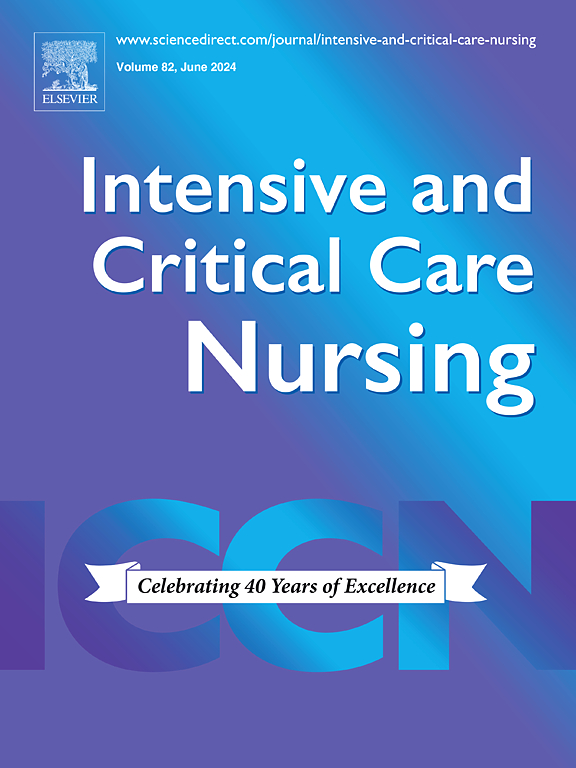急性低氧血症呼吸衰竭患者接受高流量治疗效果的相关因素:一项观察性研究。
IF 4.9
2区 医学
Q1 NURSING
引用次数: 0
摘要
落后:COVID-19 大流行严重考验了全球卫生系统。无创呼吸支持,特别是结合高流量鼻插管(HFNC)和持续气道正压,可有效治疗 COVID-19 引起的急性低氧血症呼吸衰竭并降低死亡率。然而,与无创通气相比,单独使用 HFNC 更舒适、耐受性更好、成本更低。了解哪些患者能从 HFNC 单药治疗和联合疗法中获益至关重要:这项观察性研究纳入了 2020 年 12 月至 2021 年 9 月期间入住 COVID-19 医院中级呼吸监护病房的患者。所有接受 HFNC 治疗的患者均纳入研究(n = 1301)。HFNC失败定义为需要升级治疗(无创通气、插管)或死亡。研究人员收集了流行病学、临床、无创呼吸支持参数和实验室数据,并通过多变量分析确定了关键的决定因素:结果:39.9%的患者 HFNC 成功。(n = 511)HFNC 失败的风险因素包括年龄增大、男性、肥胖、阻塞性睡眠呼吸暂停、呼吸频率较高、初始 SpO2/FiO2 ≤ 148 和初始 PaO2/FiO2 ≤ 100。24 小时后 ROX 指数的增加和疾病进展的减缓与治疗成功有关。这些发现促使我们开发了一种指数,用于识别从 HFNC 单一疗法中获益最多的患者:结论:HFNC 单一疗法对 COVID-19 导致的急性低氧血症呼吸衰竭患者的特定情况有效。该工具有助于更合理地管理这些患者。我们还需要进一步研究,以确定这些发现是否适用于由其他病症引起的急性低氧血症性呼吸衰竭:本研究强调了中级呼吸监护病房早期识别和管理有 HFNC 功能衰竭风险的患者的重要性。通过识别年龄、合并症和呼吸指数等因素,医疗服务提供者可以实施有针对性的策略,以提高 HFNC 的成功率。这些策略可能包括更严格的监测、量身定制的呼吸支持,以及在必要时及时升级到更强化的疗法。我们的研究结果凸显了在重症监护环境中采用综合方法管理严重呼吸衰竭的必要性,最终可改善患者的预后并减轻医疗系统的负担。本文章由计算机程序翻译,如有差异,请以英文原文为准。
Factors associated with the effectiveness of high-flow therapy in patients with acute hypoxemic respiratory failure: An observational study
Backward
The COVID-19 pandemic has severely tested global health systems. Non-invasive respiratory support, especially combining high-flow nasal cannula (HFNC) and continuous positive airway pressure, has effectively treated COVID-19 induced Acute Hypoxemic Respiratory Failure and reduced mortality. However, HFNC alone is more comfortable, better tolerated, and less costly than non-invasive ventilation. Understanding which patients benefit from HFNC monotherapy versus combined therapies is essential.
Methods
This observational study included patients admitted to the intermediate respiratory care unit of a COVID-19 hospital between December 2020 and September 2021. All patients treated with HFNC were included (n = 1301). HFNC failure was defined as the need for escalated therapy (non-invasive ventilation, intubation) or death. Epidemiological, clinical, non-invasive respiratory support parameters, and laboratory data were collected, and a multivariable analysis identified key determinants.
Results
HFNC was successful in 39.9 % of patients. (n = 511) Risk factors for HFNC failure included increased age, male gender, obesity, obstructive sleep apnea, higher respiratory rate, initial SpO2/FiO2 ≤ 148, and initial PaO2/FiO2 ≤ 100. An increase in the ROX Index at 24 h and slower disease progression were associated with successful treatment. These findings led to the developmet of an index to identify patients who benefit most from HFNC monotherapy.
Conclusions
HFNC monotherapy can be effective for a specific profile of patients with Acute Hypoxemic Respiratory Failure due to COVID-19. This tool may help manage these patients more appropriately. Further studies are needed to determine if these findings can be applied to Acute Hypoxemic Respiratory Failure caused by other pathologies.
Implications for Clinical Practice
This study underscores the importance of early identification and management of patients at risk of HFNC failure in intermediate respiratory care units. By recognizing factors such as age, comorbidities, and respiratory indices, healthcare providers can implement targeted strategies to enhance HFNC success. These strategies may include more stringent monitoring, tailored respiratory support, and timely escalation to more intensive therapies if needed. Our findings highlight the need for a comprehensive approach to managing severe respiratory failure in critical care settings, ultimately improving patient outcomes and reducing the burden on healthcare systems.
求助全文
通过发布文献求助,成功后即可免费获取论文全文。
去求助
来源期刊

Intensive and Critical Care Nursing
NURSING-
CiteScore
6.30
自引率
15.10%
发文量
144
审稿时长
57 days
期刊介绍:
The aims of Intensive and Critical Care Nursing are to promote excellence of care of critically ill patients by specialist nurses and their professional colleagues; to provide an international and interdisciplinary forum for the publication, dissemination and exchange of research findings, experience and ideas; to develop and enhance the knowledge, skills, attitudes and creative thinking essential to good critical care nursing practice. The journal publishes reviews, updates and feature articles in addition to original papers and significant preliminary communications. Articles may deal with any part of practice including relevant clinical, research, educational, psychological and technological aspects.
 求助内容:
求助内容: 应助结果提醒方式:
应助结果提醒方式:


